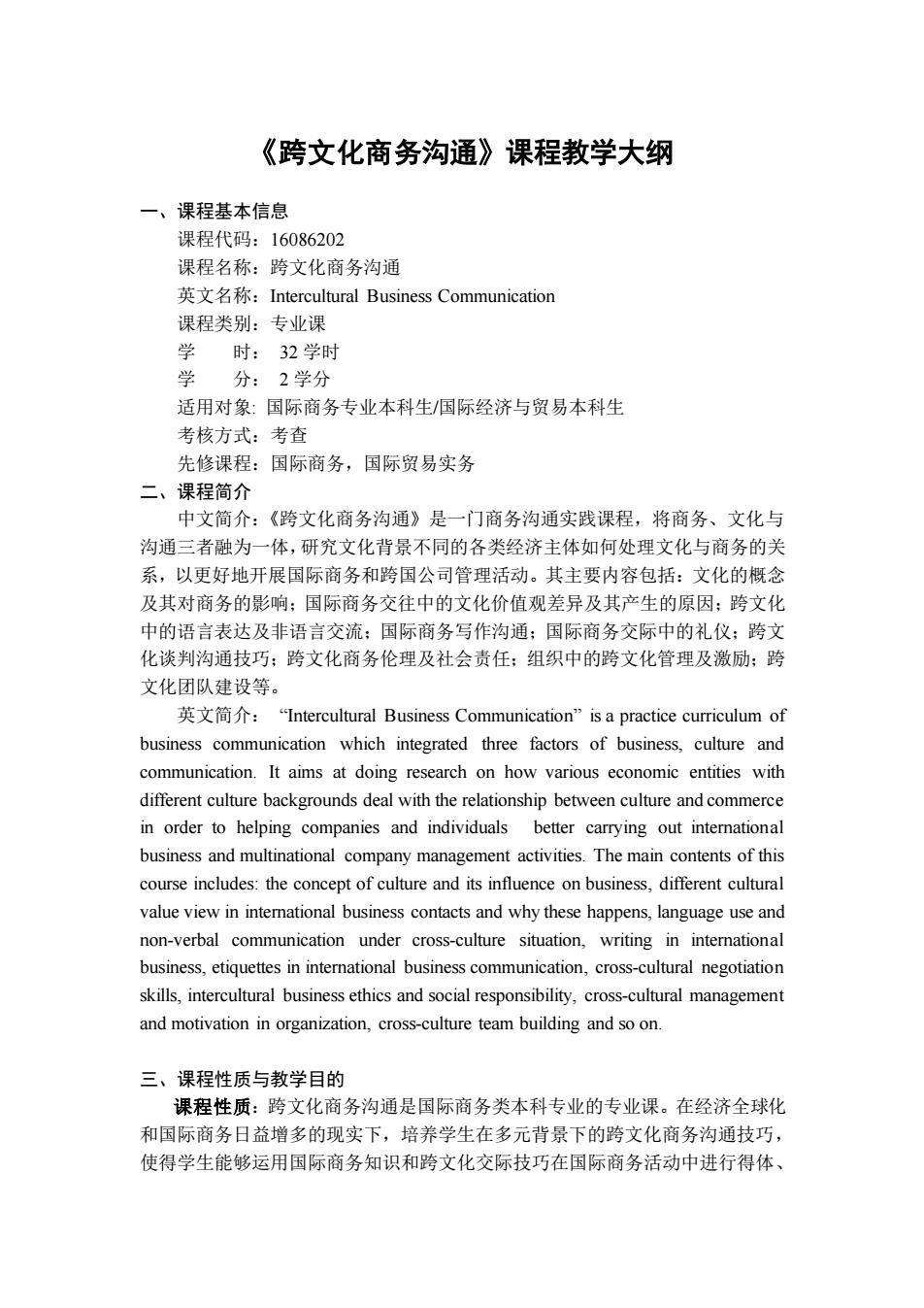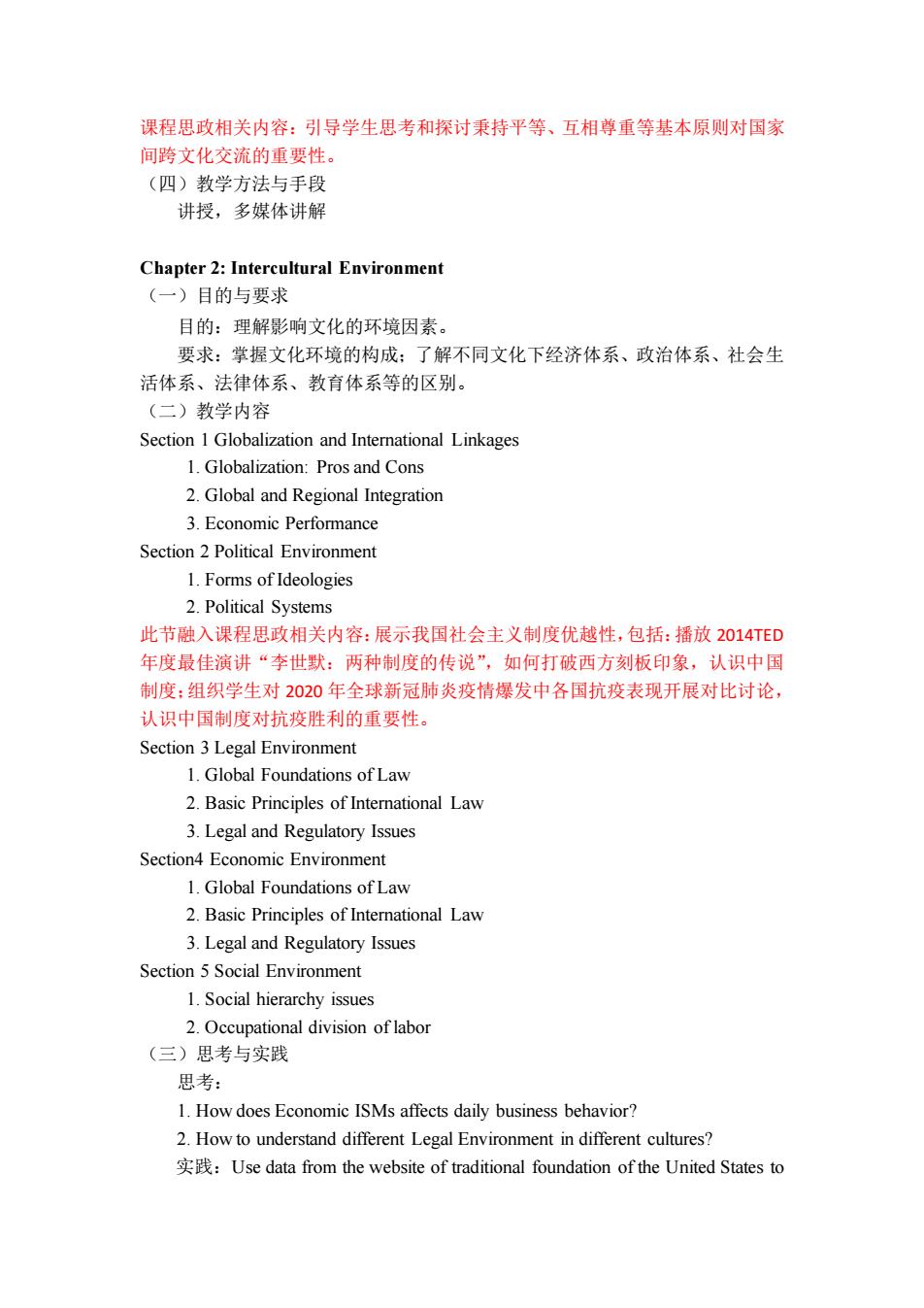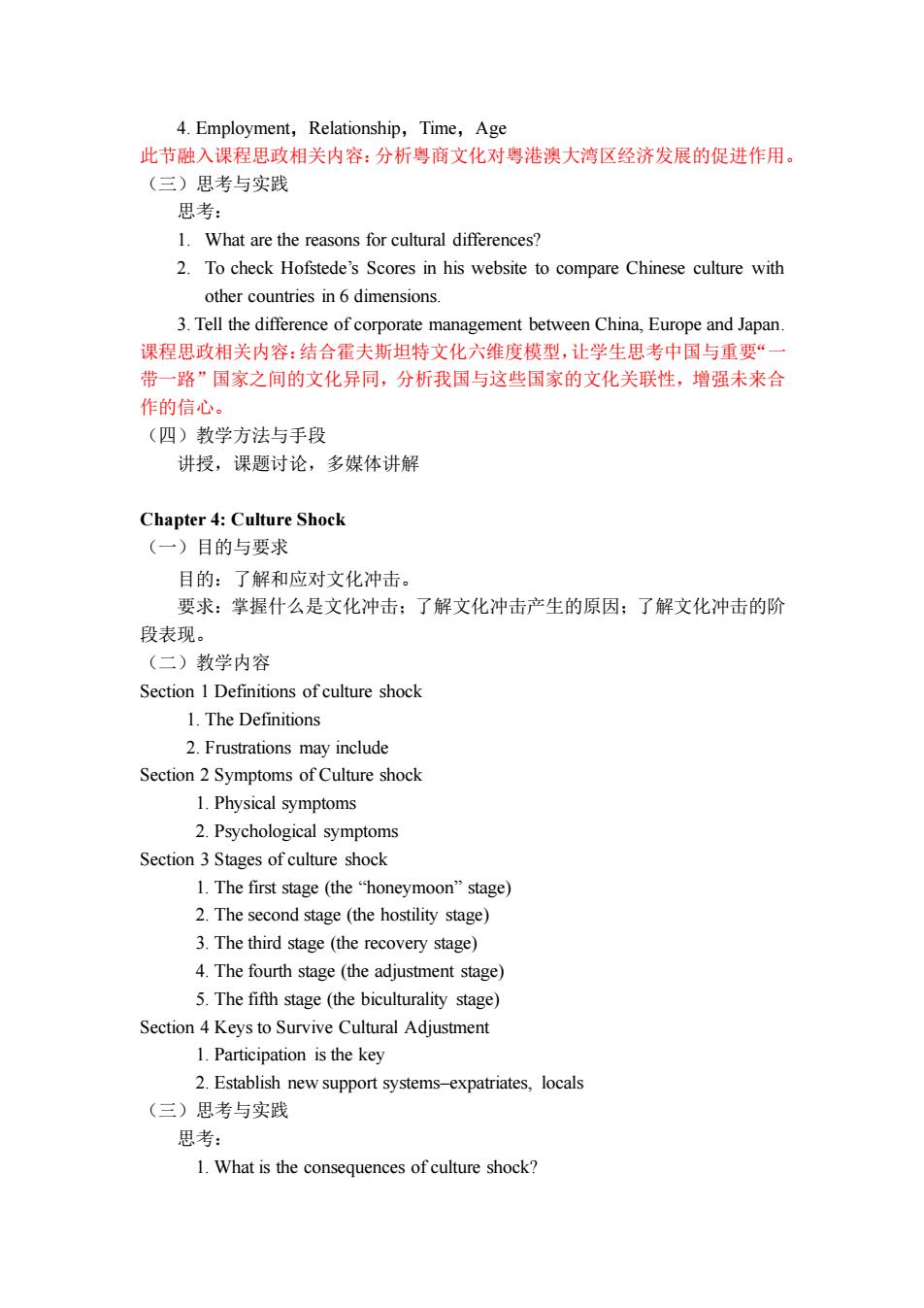
《跨文化商务沟通》课程教学大纲 一、课程基本信息 课程代码:16086202 课程名称:跨文化商务沟通 英文名称:Intercultural Business Communication 课程类别:专业课 学 时:32学时 学分:2学分 适用对象:因际商务专业本科生国际经济与贸易本科生 考核方式:考查 先修课程:国际商务,国际贸易实务 二、课程简介 中文简介:《跨文化商务沟通》是一门商务沟通实践课程,将商务、文化与 沟通三者融为一体,研究文化背景不同的各类经济主体如何处理文化与商务的关 系,以更好地开展国际商务和跨国公司管理活动。其主要内容包括:文化的概念 及其对商务的影响:国际商务交往中的文化价值观差异及其产生的原因:跨文化 中的语言表达及非语言交流:国际商务写作沟通;国际商务交际中的礼仪:跨文 化谈判沟通技巧:跨文化商务伦理及社会责任:组织中的跨文化管理及激励:跨 文化团队建设等。 英文简介:"Intercultural Business Communication”is a practice curriculum of business communication which integrated three factors of business,culture and communication.It aims at doing research on how various economic entities with different culture backgrounds deal with the relationship between culture and commerce in order to helping companies and individuals better carrying out intemationa business and multinational company management activities.The main contents of this course includes:the concept of culture and its influence on business,different cultural value view in intemational business contacts and why these happens,language use and non-verbal communication under cross-culture situation,writing in international business,etiquettes in international business communication,cross-cultural negotiation skills,intercultural business ethics and social responsibility,cross-cultural management and motivation in organization,cross-culture team building and so on. 三、课程性质与教学目的 课程性质:跨文化商务沟通是国际商务类本科专业的专业课。在经济全球化 和国际商务日益增多的现实下,培养学生在多元背景下的跨文化商务沟通技巧, 使得学生能够运用国际商务知识和跨文化交际技巧在国际商务活动中进行得体
《跨文化商务沟通》课程教学大纲 一、课程基本信息 课程代码:16086202 课程名称:跨文化商务沟通 英文名称:Intercultural Business Communication 课程类别:专业课 学 时: 32 学时 学 分: 2 学分 适用对象: 国际商务专业本科生/国际经济与贸易本科生 考核方式:考查 先修课程:国际商务,国际贸易实务 二、课程简介 中文简介:《跨文化商务沟通》是一门商务沟通实践课程,将商务、文化与 沟通三者融为一体,研究文化背景不同的各类经济主体如何处理文化与商务的关 系,以更好地开展国际商务和跨国公司管理活动。其主要内容包括:文化的概念 及其对商务的影响;国际商务交往中的文化价值观差异及其产生的原因;跨文化 中的语言表达及非语言交流;国际商务写作沟通;国际商务交际中的礼仪;跨文 化谈判沟通技巧;跨文化商务伦理及社会责任;组织中的跨文化管理及激励;跨 文化团队建设等。 英文简介: “Intercultural Business Communication” is a practice curriculum of business communication which integrated three factors of business, culture and communication. It aims at doing research on how various economic entities with different culture backgrounds deal with the relationship between culture and commerce in order to helping companies and individuals better carrying out international business and multinational company management activities. The main contents of this course includes: the concept of culture and its influence on business, different cultural value view in international business contacts and why these happens, language use and non-verbal communication under cross-culture situation, writing in international business, etiquettes in international business communication, cross-cultural negotiation skills, intercultural business ethics and social responsibility, cross-cultural management and motivation in organization, cross-culture team building and so on. 三、课程性质与教学目的 课程性质:跨文化商务沟通是国际商务类本科专业的专业课。在经济全球化 和国际商务日益增多的现实下,培养学生在多元背景下的跨文化商务沟通技巧, 使得学生能够运用国际商务知识和跨文化交际技巧在国际商务活动中进行得体

有效的沟通,展现中国文化自信显得尤为重要。本课程主要面向国际商务专业 及国际经济与贸易专业学生。 教学目的:(1)以跨文化交际学的基本理论为框架,让学生理解文化之间只 有差异之分、而无优劣之分,认识到文化价值观差异对商务活动存在一定影响, 对文化的内涵及产生根源有客观的认识;(2)能较好地掌握在不同文化背景下的 语言、非语言沟通、商务文字表达及其他沟通手段:(3)在现实的国际商务活动 中具备较好的国际礼仪,能适当运用跨文化谈判技巧,跨文化团队建设方法开展 国际商务交流,能够向不同国家展示中国优秀的商务文化、职业作风,传递中国 文化的包容性和开放性。 四、教学内容及要求 Chapter 1The Nature of Intercultural Business Communication (一)目的与要求 目的:了解跨文化商务沟通相关基本概念。 要求:理解文化的含义及跨文化相关概念:了解跨文化商务沟通的内涵:掌 握跨文化沟通对沟通者的要求。 (一)教学内容 Section 1 Basics of Human Communication 1.Definition of communication 2.The scope and classification of communication 3.The process of communication 4.Characteristics of communication Section 2A review of intercultural communication study 1.Intercultural communication study in foreign countries 2.Intercultural communication study in China 此节融入课程思政相关内容:在分析中国与其他国家的跨文化交往历史时,重点 突出我国与亚非拉发展中国家的文化、经济和政治交往历史,让学生认识到我国 国际交往中的大国风范和基本准则,包括和平共处五项基本原则、对不发达地区 的扶持、南南合作相关区域组织、孔子学院的文化传播等 Section 3 A review of intercultural business communication 1.The complexity in leaming intercultural business communication 2.The influence of failing intercultural business communication (三)思考与实践 思考: 1.What are the Basics of Human Communication? 2.How to defy Intercultural business communication? 3.What are the dimensions of interclutural communication?
有效的沟通,展现中国文化自信显得尤为重要。本课程主要面向国际商务专业, 及国际经济与贸易专业学生。 教学目的:(1)以跨文化交际学的基本理论为框架,让学生理解文化之间只 有差异之分、而无优劣之分,认识到文化价值观差异对商务活动存在一定影响, 对文化的内涵及产生根源有客观的认识;(2)能较好地掌握在不同文化背景下的 语言、非语言沟通、商务文字表达及其他沟通手段;(3)在现实的国际商务活动 中具备较好的国际礼仪,能适当运用跨文化谈判技巧,跨文化团队建设方法开展 国际商务交流,能够向不同国家展示中国优秀的商务文化、职业作风,传递中国 文化的包容性和开放性。 四、教学内容及要求 Chapter 1 The Nature of Intercultural Business Communication (一)目的与要求 目的:了解跨文化商务沟通相关基本概念。 要求:理解文化的含义及跨文化相关概念;了解跨文化商务沟通的内涵;掌 握跨文化沟通对沟通者的要求。 (二)教学内容 Section 1 Basics of Human Communication 1. Definition of communication 2. The scope and classification of communication 3. The process of communication 4. Characteristics of communication Section 2 A review of intercultural communication study 1. Intercultural communication study in foreign countries. 2. Intercultural communication study in China. 此节融入课程思政相关内容:在分析中国与其他国家的跨文化交往历史时,重点 突出我国与亚非拉发展中国家的文化、经济和政治交往历史,让学生认识到我国 国际交往中的大国风范和基本准则,包括和平共处五项基本原则、对不发达地区 的扶持、南南合作相关区域组织、孔子学院的文化传播等。 Section 3 A review of intercultural business communication 1. The complexity in learning intercultural business communication 2. The influence of failing intercultural business communication (三)思考与实践 思考: 1. What are the Basics of Human Communication? 2. How to defy Intercultural business communication? 3. What are the dimensions of interclutural communication?

课程思政相关内容:引导学生思考和探讨秉持平等、互相尊重等基本原则对国家 间跨文化交流的重要性。 (四)教学方法与手段 讲授,多媒体讲解 Chapter 2:Intercultural Environment (一)目的与要求 目的:理解影响文化的环境因素 要求:掌握文化环境的构成:了解不同文化下经济体系、政治体系、社会生 活体系、法律体系、教育体系等的区别。 (二)教学内容 Section 1 Globalization and Intemational Linkages 1.Globalization:Pros and Cons 2.Global and Regional Integration 3.Economic Performance Section 2 Political Environment 1.Forms of Ideologies 2.Political Systems 此节融入课程思政相关内容:展示我国社会主义制度优越性,包括:播放2014TED 年度最佳演讲“李世默:两种制度的传说”,如何打破西方刻板印象,认识中国 制度:组织学生对2020年全球新冠肺炎疫情爆发中各国抗疫表现开展对比讨论, 认识中国制度对抗疫胜利的重要性。 Section 3 Legal Environment 1.Global Foundations of Law 2.Basic Principles of International Law 3.Legal and Regulatory Issues Section4 Economic Environment 1.Global Foundations of Law 2.Basic Principles of International Law 3.Legal and Regulatory Issues Section 5 Social Environment 1.Social hierarchy issues 2.Occupational division of labo (三)思考与实我 思考: 1.How does Economic ISMs affects daily business behavior? 2.How to understand different Legal Environment in different cultures? Use data from the website of traditional foundation of the United States to
课程思政相关内容:引导学生思考和探讨秉持平等、互相尊重等基本原则对国家 间跨文化交流的重要性。 (四)教学方法与手段 讲授,多媒体讲解 Chapter 2: Intercultural Environment (一)目的与要求 目的:理解影响文化的环境因素。 要求:掌握文化环境的构成;了解不同文化下经济体系、政治体系、社会生 活体系、法律体系、教育体系等的区别。 (二)教学内容 Section 1 Globalization and International Linkages 1. Globalization: Pros and Cons 2. Global and Regional Integration 3. Economic Performance Section 2 Political Environment 1. Forms of Ideologies 2. Political Systems 此节融入课程思政相关内容:展示我国社会主义制度优越性,包括:播放 2014TED 年度最佳演讲“李世默:两种制度的传说”,如何打破西方刻板印象,认识中国 制度;组织学生对 2020 年全球新冠肺炎疫情爆发中各国抗疫表现开展对比讨论, 认识中国制度对抗疫胜利的重要性。 Section 3 Legal Environment 1. Global Foundations of Law 2. Basic Principles of International Law 3. Legal and Regulatory Issues Section4 Economic Environment 1. Global Foundations of Law 2. Basic Principles of International Law 3. Legal and Regulatory Issues Section 5 Social Environment 1. Social hierarchy issues 2. Occupational division of labor (三)思考与实践 思考: 1. How does Economic ISMs affects daily business behavior? 2. How to understand different Legal Environment in different cultures? 实践:Use data from the website of traditional foundation of the United States to

check and compare Economic Freedom Index between different countries 课程思政相关内容:上学生结合我困历年吸收对外直接投资的数据,搜集外资在 华经营的案例,思考以下问题:我国政府如何大力提升营商环境,以何种实际行 动增强外资投资中国、做多中国的信心与决心。为此,让学生理解中国融入国际 体系、贡献中国智慧的事实。 (四)教学方法与手段 讲授,多媒体讲解 Chapter3:Culture:Values and influence on Business (一)目的与要求 目的:理解价值观对商务形象的影响。 要求:掌握文化的定义和内涵:掌握价值观的定义及其构成要素:了解霍夫 斯泰德的文化六维度模型:掌握文化价值观对商务行为产生影响的不同表现方式。 (二)教学内容 Section 1 The Nature of Culture 1.Definition of Culture 2.Ingredients of Culture 3.Characteristics of Culture 此节融入课程思政相关内容:强调不同国家或民族的文化只有差异之分,而无优 劣之分。在与不同国家的企业和个人交往中,首先要秉持我国文化自信,同时也 要尊重他国文化,做到不卑不亢、理解包容。 Section 2 The Basics of Cultural Values 1.Definition of Values 2.Values Form the Core of Culture 3 Priorities of Cultural values Section 3 Understanding Cultural Patterns 1.Kluckhohn and Strodtbeck's Value Orientation 2.Hofstede-Bond's Value Dimensions 3.Trompenaars'Value Dimensions 4.Schwartz's Value Inventory 5.Hall's High-and low-context Orientation 此节融入课程思政相关内容:强调不同国家或民族的文化只有差异之分,而无优 劣之分。在与不同国家的企业和个人交往中,首先要秉持我国文化自信,同时也 要尊重他国文化,做到不卑不亢、理解包容。 Section 4 Values on Business 1 Work Attitudes 2.Attitudes Toward Women 3.Corporate management
check and compare Economic Freedom Index between different countries. 课程思政相关内容:让学生结合我国历年吸收对外直接投资的数据,搜集外资在 华经营的案例,思考以下问题:我国政府如何大力提升营商环境,以何种实际行 动增强外资投资中国、做多中国的信心与决心。为此,让学生理解中国融入国际 体系、贡献中国智慧的事实。 (四)教学方法与手段 讲授,多媒体讲解 Chapter 3:Culture: Values and influence on Business (一)目的与要求 目的:理解价值观对商务形象的影响。 要求:掌握文化的定义和内涵;掌握价值观的定义及其构成要素;了解霍夫 斯泰德的文化六维度模型;掌握文化价值观对商务行为产生影响的不同表现方式。 (二)教学内容 Section 1 The Nature of Culture 1. Definition of Culture 2. Ingredients of Culture 3. Characteristics of Culture 此节融入课程思政相关内容:强调不同国家或民族的文化只有差异之分,而无优 劣之分。在与不同国家的企业和个人交往中,首先要秉持我国文化自信,同时也 要尊重他国文化,做到不卑不亢、理解包容。 Section 2 The Basics of Cultural Values 1. Definition of Values 2. Values Form the Core of Culture 3. Priorities of Cultural Values Section 3 Understanding Cultural Patterns 1. Kluckhohn and Strodtbeck’s Value Orientation 2. Hofstede-Bond’s Value Dimensions 3. Trompenaars’ Value Dimensions 4. Schwartz’s Value Inventory 5. Hall’s High- and low-context Orientation 此节融入课程思政相关内容:强调不同国家或民族的文化只有差异之分,而无优 劣之分。在与不同国家的企业和个人交往中,首先要秉持我国文化自信,同时也 要尊重他国文化,做到不卑不亢、理解包容。 Section 4 Values on Business 1. Work Attitudes 2. Attitudes Toward Women 3.Corporate management

4.Employment,Relationship,Time,Age 此节融入课程思政相关内容:分析粤商文化对粤港澳大湾区经济发展的促进作用。 (三)思考与实践 思老: 1.What are the reasons for cultural differences? 2.To check Hofstede's Scores in his website to compare Chinese culture with other countries in6 dimensions. 3.Tell the difference of corporate management between China,Europe and Japan. 课程思政相关内容:结合霍夫斯坦特文化六维度模型,让学生思考中国与重要 带一路”国家之间的文化异同,分析我国与这些国家的文化关联性,增强未来合 作的信心。 (四)教学方法与手段 讲授,课题讨论,多媒体讲解 Chapter 4:Culture Shock (一)目的与要求 目的:了解和应对文化冲击。 要求:掌握什么是文化冲击;了解文化冲击产生的原因:了解文化冲击的阶 段表现。 (二)教学内容 Section 1 Definitions of culture shock 1.The Definitions 2.Frustrations may include Section 2 Symptoms of Culture shock 1.Physical symptoms 2.Psychological symptoms Section 3 Stages of culture shock 1.The first stage(the"honeymoon"stage) 2.The second stage(the hostility stage) 3.The third stage (the recovery stage) 4.The fourth stage(the adjustment stage) 5.The fifth stage (the biculturality stage) Section 4 Keys to Survive Cultural Adjustment 1.Participation is the key 2.Establish new support systemsexpatriates.ocals (三)思考与实践 思考: 1.What is the consequences of culture shock?
4. Employment,Relationship,Time,Age 此节融入课程思政相关内容:分析粤商文化对粤港澳大湾区经济发展的促进作用。 (三)思考与实践 思考: 1. What are the reasons for cultural differences? 2. To check Hofstede’s Scores in his website to compare Chinese culture with other countries in 6 dimensions. 3. Tell the difference of corporate management between China, Europe and Japan. 课程思政相关内容:结合霍夫斯坦特文化六维度模型,让学生思考中国与重要“一 带一路”国家之间的文化异同,分析我国与这些国家的文化关联性,增强未来合 作的信心。 (四)教学方法与手段 讲授,课题讨论,多媒体讲解 Chapter 4: Culture Shock (一)目的与要求 目的:了解和应对文化冲击。 要求:掌握什么是文化冲击;了解文化冲击产生的原因;了解文化冲击的阶 段表现。 (二)教学内容 Section 1 Definitions of culture shock 1. The Definitions 2. Frustrations may include Section 2 Symptoms of Culture shock 1. Physical symptoms 2. Psychological symptoms Section 3 Stages of culture shock 1. The first stage (the “honeymoon” stage) 2. The second stage (the hostility stage) 3. The third stage (the recovery stage) 4. The fourth stage (the adjustment stage) 5. The fifth stage (the biculturality stage) Section 4 Keys to Survive Cultural Adjustment 1. Participation is the key 2. Establish new support systems–expatriates, locals (三)思考与实践 思考: 1. What is the consequences of culture shock?